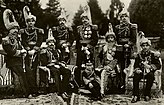This article needs additional citations for verification. (September 2011) |
| Rana dynasty राणा वंश Ranas of Nepal | |
|---|---|
 | |
 | |
| Parent family | Kunwar family |
| Country | Kingdom of Nepal |
| Founded | 1846 |
| Founder | Bir Narsingh Kunwar (Jung Bahadur Rana) |
| Current head | Pashupati Shumsher Rana |
| Final ruler | Mohan Shumsher Rana |
| Titles | Shree Teen Maharaja of Nepal, Maharaja of Lamjung and Kaski |
| Motto | |
| Properties | Rana palaces of Nepal |
| Dissolution | 1951 |
| Rana Dynasty 1846–1951 CE | ||||||||||||||||||||||
|---|---|---|---|---|---|---|---|---|---|---|---|---|---|---|---|---|---|---|---|---|---|---|
|
||||||||||||||||||||||
The Rana dynasty ([राणा वंश] Error: {{Langx}}: invalid parameter: |IAST= (help) Sanskrit: [raːɳaː ʋɐ̃ɕɐ], Nepali: [raɳa bʌŋsʌ]) was a Chhetri[note 1] dynasty that[6] imposed authoritarianism in the Kingdom of Nepal from 1846 until 1951, reducing the Shah monarch to a figurehead and making the Prime Minister and other government positions held by the Ranas hereditary. The Rana dynasty is historically known for their iron-fisted rule in Nepal.[7] This changed after the Revolution of 1951 with the promulgation of a new constitution, when power shifted back to the monarchy of King Tribhuvan.[8]
The Rana dynasty were descended from the Kunwar family, a nobility of the Gorkha Kingdom.[9] Due to their marital lineages with the politically reigning Thapa dynasty (of Mukhtiyar Bhimsen Thapa) from the early 19th century, the Ranas gained entry to central Darbar politics.[10][5] The Ranas were also linked to a minor faction of the Pande dynasty of Gorkha through the Thapa dynasty.[5]
- ^ Dor Bahadur Bista 1991, p. 37.
- ^ Sharma Baral 1964, p. 111.
- ^ Regmi 1975, p. 90.
- ^ Wright 1877, p. 285.
- ^ a b c Cite error: The named reference
PurushottamShamsher1990was invoked but never defined (see the help page). - ^ Van PraaghD (2003). Greater Game. MQUP. p. 319. ISBN 978-0-7735-7130-3. Archived from the original on 11 September 2017. Retrieved 11 September 2017.
- ^ "The Rana reign | Nepali Times Buzz | Nepali Times".
- ^ Kraemer, Karl-Heinz. "Democratization and political parties in Nepal". Harvard University. Archived from the original on 24 May 2013. Retrieved 25 November 2012.
- ^ Joshi & Rose 1966, p. 30.
- ^ Acharya 2012, p. 11-12.
Cite error: There are <ref group=note> tags on this page, but the references will not show without a {{reflist|group=note}} template (see the help page).

